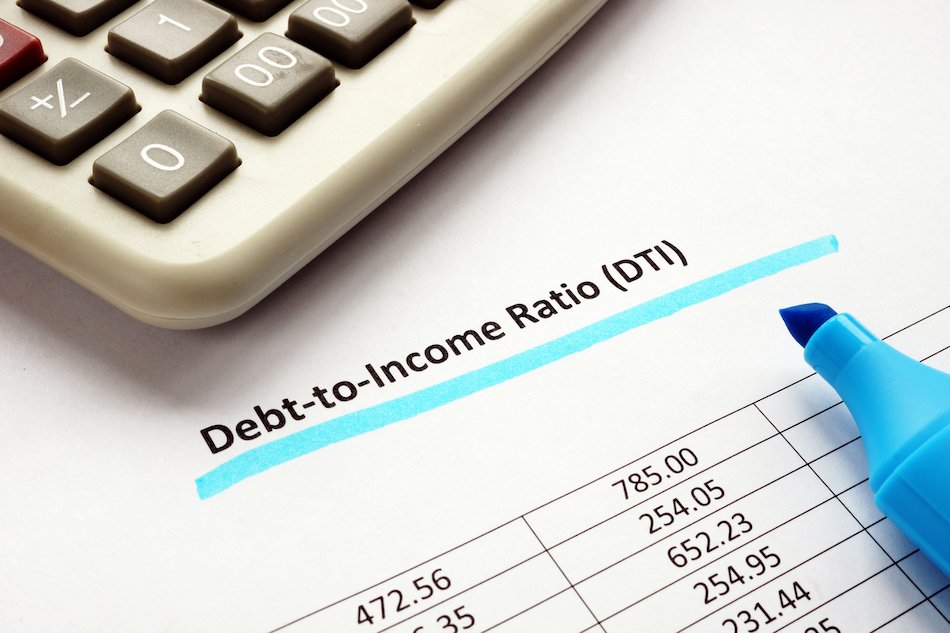
In addition to factors such as credit score and loan-to-value, a debt to income ratio is used by a lender to determine whether to make an investment property loan.
If a ratio is too high, a lender may view it as a red flag that a borrower may be unable to pay the mortgage. A high debt to income ratio is also a sign to an investor that there may be insufficient cash flow to pay for the cost of owning and operating an investment property.
In this article, we’ll take a closer look at why debt to income ratio for investment property is important, how to accurately calculate the ratio, and ways to improve a debt to income ratio.
Key takeaways
- Debt to income ratio or DTI is the amount of a borrower’s gross monthly income that is used for debt payments.
- Gross monthly income is money earned before any withholdings or deductions are made.
- Lenders generally prefer to see a total debt to income ratio of 36%, but may go as high as 50%, depending on a borrower’s credit score, down payment, and the loan program being used.
- A lender may use existing or anticipated rental income from an investment property when calculating a borrower’s DTI.
What is debt to income ratio for investment property?
The debt to income (DTI) ratio for investment property compares a borrower’s percentage of gross monthly income that is used for debt payments. Gross monthly income is the amount of money earned each month before any withholdings or deductions are made.
Lenders review the DTI of a borrower to determine the level of risk if a borrower takes on more debt, such as financing the purchase of an investment property.

How to calculate debt to income ratio
The debt to income ratio formula looks like this:
- Debt to Income Ratio = Monthly Debt Payments / Gross Monthly Income
For example, if a borrower’s total monthly debt payments are $3,000 and the gross monthly income is $10,000, the debt to income ratio would be 30%.
While the debt to income ratio formula is easy to use, it’s important to understand the different income and debt components that go into the calculation in order to accurately determine DTI.
Gross monthly income
- Rental income received each month.
- Additional income such as roommate rent or pet rent.
- Other income, such as from a full-time “day job” or disability, child, or spousal support payments.
All sources of income – including rental income – must be documented when applying for a mortgage to purchase an investment property or to refinance an existing loan.
Examples of documentation might include monthly bank statements showing the amount of rent received and when, a copy of IRS Schedule E (Form 1040) used to report rental real estate income and loss, or copies of cancelled rent checks from a tenant.
To include rental income as part of a borrower’s gross monthly income, a borrower must demonstrate to a lender that the rental income is likely to continue. In some cases, depending on the specific lender, rental income may only be considered if it has been received for the prior 2 years.
“Other income” is included in a debt to income ratio because income from a rental property is not the primary source of income for most borrowers, at least unless they reach the point where they quit their jobs to focus on their real estate business.
Monthly debt payments
Debt payments are often divided into two categories. Front-end debt payments are housing-related expenses, while back-end payments are minimum monthly debt payments used for other recurring debt.
Front-end debt payments
- Mortgage payment primary residence (principal, interest, taxes, insurance)
- Mortgage payment rental property (principal and interest)
- Property taxes
- Landlord insurance coverage
- Hazard insurance premium
- Mortgage insurance premium (MIP) or private mortgage insurance premium (PMI), if applicable
- Homeowner’s association dues, if applicable
Back-end debt payments
- Credit cards
- Auto loans
- Personal loans
- Student loans
- Medical bills with a repayment plan
- Alimony payments
- Child support payments
Example of DTI for an investment property
Now let’s look at an example of how to calculate the debt to income ratio for an investment property.
We’ll assume a borrower plans on purchasing a single-family rental home for $120,000 using a 25% down payment and financing the balance of the purchase price. Over the past 2 years, the rental property has generated a monthly gross rent of $1,200 per month, and operating expenses (excluding the mortgage payment) are $350 per month.
The DTI ratio is calculated by dividing the total monthly debt payments by the total monthly gross income received by a borrower:
Income
- Gross monthly income from a full-time day job: $10,000
- Monthly rental income: $1,200
Total monthly income: $11,200
Debt
- Monthly mortgage payment on a primary residence: $1,300 (principal, interest, taxes, insurance)
- Monthly mortgage payment rental property: $425
- Operating expenses, rental property: $350
- Recurring debt payments: $1,500 (credit card, auto loan, student loan)
Total monthly debt payments: $3,575
- DTI = Monthly Debt Payments / Monthly Income
- $3,575 monthly debt payments / $10,000 monthly income = 35.75% DTI

What is a good debt to income ratio?
As a rule of thumb, the lower a borrower’s DTI is the less risk there is to a lender, everything else being equal. Lenders generally prefer a debt to income ratio of about 36%, but the maximum debt to income ratio may vary based on the lender and loan program being used.
For example, an FHA loan may allow a maximum DTI of 43% for a borrower with a minimum credit score of 500, while VA loans typically allow a borrower to have a maximum DTI of 41%.
On the other hand, conventional loans originated by a bank or credit union generally allow a maximum DTI of 45%. If a borrower has a strong credit score or a large amount of cash held in reserve, a lender may allow at DTI as high as 50%.
Does future rental income qualify for DTI?
Sometimes investors purchase vacant homes that need to be rented, or they buy single-family homes that have never been used as rental property before. In cases like these where there is no existing rental income, a lender may still accept future or predicted rental income when calculating a borrower’s DTI.
For example, if a home has a history of being rented for $1,200 per month but is currently vacant, a lender may apply 75% (or $900) of the predicted future rental income to a borrower’s total gross income. If the property has never been rented before, a lender may have an appraiser conduct a rent analysis to determine the fair market rent and determine the potential rental income.
There are also some instances where a lender may be unable to accept future or current rental income when underwriting a loan for an investment property. Cash rent payments made by a tenant each month are difficult to document if there is no proof how much rent is being paid and when it is received.
Another example of rental income that may be difficult to qualify for DTI is if a property is leased to a tenant paying an above-market rent. If a tenant is paying $1,200 per month but the fair market rent is $1,000, a lender may use the lower rent amount when determining how much rent to add to a borrower’s income.
How to improve a debt to income ratio
The debt to income ratio for an investment property loan can be improved by increasing income, lowering debt, or a combination of both. Some ways to improve a DTI ratio include:
- Make sure that all personal income is being accounted for, including money received from a side business, an annual bonus, or any collected child or spousal support.
- Look for ways to increase the gross monthly income from an investment property, such as raising the rent to the market rate or making the property pet friendly to generate additional pet rent.
- Minimize tenant turnover by screening for the most qualified tenants and offering an incentive to a good tenant to renew a lease.
- Pay off high-interest debt from an auto loan, personal loan, or credit card balances to reduce the monthly debt payment amount.
- Consider making a larger down payment on an investment property to lower the monthly mortgage payment.
- Hire a professional property manager with a local network of cost effective vendors and suppliers to help keep operating expenses low.


